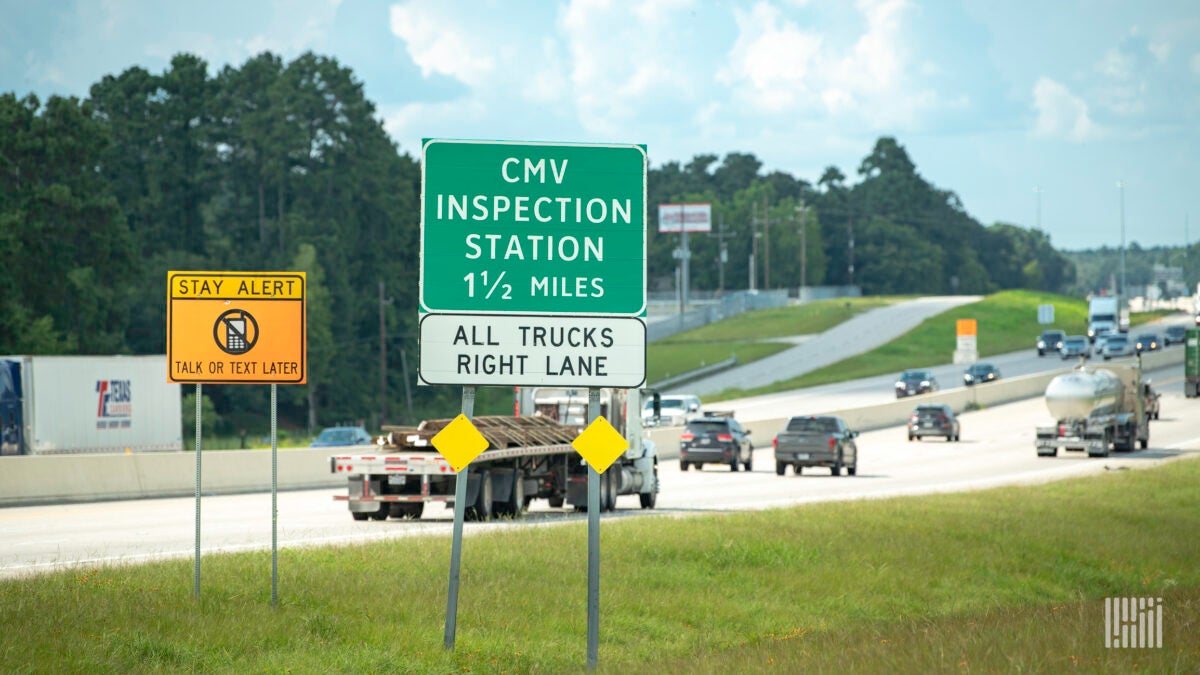
FMCSA delays closely watched trucking rulemaking until 2025

Major rulemaking deadlines were again extended as the Federal Motor Carrier Safety Administration pushed back several decisions to 2025. The FMCSA’s proposed truck speed limiter rule was scheduled to be published this June but is now delayed to May 2025. It would require that trucks over 26,000 pounds be equipped with an electronic speed governor set to a currently undetermined maximum speed. This is the second time the rule has been pushed, with the first being originally scheduled by mid-2023.
Proposed changes to ELDs and whether they should apply to engines before 2000 were also pushed back from October 2024 to June 2025. Additionally, rulemaking involving automatic emergency braking systems, originally scheduled for April 2024, is now delayed until January 2025. This final rule is a joint effort by the FMCSA and National Highway Traffic Safety Administration.
FreightWaves’ John Gallagher wrote, “Other delayed rulemaking dockets include automated driving systems in heavy trucks (from March 2024 to December 2024), improving safety for female truck drivers (from June 2024 to December 2024), and new physical qualification standards for truck drivers with epilepsy (from July 2024 to June 2025).”
FMCSA officials declined to comment on the reasons behind the delays.
SBA disaster loans’ possible impact on the Great Freight Recession
FreightWaves recently acquired data from the Small Business Administration (SBA) about the COVID-19 Economic Injury Disaster Loan (EIDL) program and its impact on the trucking space.
The first question was how much money went out. FreightWaves’ JP Hampstead writes, “The answer came back: $37 billion was lent to the transportation and warehousing sector (NAICS Sector 48-49) across 419,500 loans for an average loan amount of $88,200. In sector 48-49, there are 723,573 total businesses employing a total of 726,238 people. Of those people working in the sector, 539,702 work at firms with only 1-4 employees. In other words, the majority of the sector is composed of small businesses, and 58% of them received COVID EIDL loans.”
Looking at the ramifications of the loans, Craig Fuller, founder and CEO of FreightWaves, posted on the X platform, “carriers were not pressured to repay the loans because payments were deferred for the program’s first years.” Fuller believes these loans possibly provided a cushion for trucking firms to operate for longer, even as the freight market deteriorated and spot rates dipped below profitability.
For those COVID-era SBA EIDL loans issued two years ago, payments for many are coming due. A development to watch will be whether trucking-related bankruptcies continue, not from the already challenging operating environment but from the payments themselves eroding operating margins. An added challenge is that many of these small fleets that accept loans and go bankrupt can be difficult to pinpoint, compared to the highly publicized mergers, acquisitions and bankruptcies at larger trucking companies.
Market update: Preliminary June Class 8 net orders meet expectations
ACT Research recently released its June preliminary North America Class 8 net orders for June, which saw orders fall 37% month over month to 14,800 units. Compared to June 2023, orders are 12% lower. Kenny Vieth, president and senior analyst at ACT Research, wrote, “Even in good years, Q2 typically delivers below-trend orders, while Q4 orders can trigger optimism at the bottom of the cycle. With the long bottom in freight volumes and rates continuing in the most recent data from DAT amid lingering market overcapacity, for-hire carriers’ financial performance has been dismal.”
Vieth added that while Q2 is historically the worst time of the year for orders and the bottom of tractor buyers’ profitability cycle, the recent results are still in line with expectations. One bright spot has been in medium-duty truck demand, which has benefited from consumer services spending.
Looking at the data in context, rival firm FTR Transportation Intelligence believes these numbers are in line with seasonal expectations. Commercial Carrier Journal’s Pamella De Leon wrote: “During the first three months of the year, orders averaged around 18,000 units per month. In the last three months, they have slowed to just under 16,000 units per month, which is a normal seasonal decline. Despite the slowdown, FTR said that production slots for Class 8 trucks are still being filled at a ‘steady, albeit slowing, pace.’”
FreightWaves SONAR spotlight: Spot market cools following Fourth of July weekend
Summary: The dry van spot rate rally, which began in mid-June, appears to be losing a little steam following the return of capacity after the July Fourth weekend. The FreightWaves National Truckload Index 7-Day Average fell 1 cent per mile all-in week over week from $2.38 on July 1 to $2.37. The NTI remains elevated, at its highest level since Feb. 5.
Flatbed spot market rates saw a similar post-holiday decline, falling 1 cent per mile all-in w/w from $2.89 on July 1 to $2.88. A development to watch in the flatbed segment comes from the contract space, where flatbed outbound tender rejection rates fell 282 basis points w/w, from 9.6% on July 1 to 6.78%. Month over month saw more staggering declines, with FOTRI down 970 bps, from 16.48% on June 9 to 6.78%.
Despite the dry van and flatbed slumps, reefer spot market rates fared better over the past week. RTI rose 10 cents per mile all-in from $2.63 to $2.73. Reefer outbound tender rejection rates saw a reversal, down 218 bps w/w from 10.88% to 8.7%.
The Routing Guide: Links from around the web
Minor decline in truck transportation jobs reported for June (FreightWaves)
Group frustrated by FMCSA’s reluctance to allow hair testing results in Clearinghouse (The Trucker)
Trucking’s youth movement lagging, but no retirement in sight for most drivers (Commercial Carrier Journal)
60 years on 80: Iowa 80 Truckstop celebrates decades of dedication to trucking and community (Quad-City Times)
Parts, labor costs slide again in Q1 (Trucking Dive)
EPA 2027 diesel emissions regs: Class 8 truck price hikes in the offing (OverDrive)
